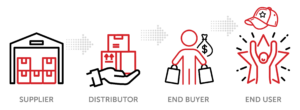
How the Promotional Product Industry Works
By Jim Hollis
By Aileen Flaherty
Promotional products are a thriving $26.1 billion industry that has shown sustained growth year after year. It’s a dynamic, multifaceted sector that plays a crucial role in marketing strategies across various industries.
Promotional products, also known as ad specialties, are items branded with a logo or slogan used in marketing and communication programs. Some of the most popular promo products include T-shirts, drinkware, mugs, pens, signage and USB drives, but anything that has space to promote a brand, company, event or cause can be considered promo.
There are several key players that make up the promotional products industry, each with distinct roles:
- Suppliers: These companies produce the products and oftentimes specialize in specific categories, such as apparel, electronics or eco-friendly items.
- Distributors: Distributors act as intermediaries between suppliers and end-users. They work with businesses to select and customize products to fit their marketing needs.
- End-Buyers: These businesses/organizations purchase promotional products to distribute to their target audiences.
- End-Users: These consumers are the end-buyers’ target audiences and the ultimate recipients of the promotional products.

Suppliers, distributors, end-buyers and end-users all work together to accomplish their respective goals, thus creating a multi-step process for creating and delivering promotional products on time and on budget:
- Concept and Design: The process begins with an idea, which is often influenced by the marketing objectives of the end-user. The design phase includes selecting products, colors and customization options.
- Sourcing: Distributors source products from suppliers. This step involves negotiating prices, ensuring quality and managing logistics.
- Customization: Once the products are sourced, they are sent to decorators for customization. This step may include printing logos, adding text or other branding elements.
- Quality Control: Before everything is finalized, the products undergo a quality control check to ensure they meet the required standards.
- Distribution: The final products are then shipped to the end-users or directly to their target audience.
As laid out in the 2023 ASI Ad Impressions Study, the power of promotional products is undeniable, and they continue to serve as one of the most effective forms of marketing and advertising. Included among the numerous benefits of promo are:
- Brand Recognition: Promo gets your name and logo out there quicker and cheaper than other forms of advertising.
- Customer Loyalty: High-quality promotional items have a shelf life of one year or more, and repeated use enhances customer loyalty and retention.
- Cost-Effectiveness: They offer a high ROI compared to other advertising methods.
- Versatility: Promotional products are used in all the top markets – including education, healthcare, finance and nonprofits – and can be deployed through various marketing campaigns, from trade shows to corporate giveaways.
The promotional products industry is a vital component of modern marketing strategies, offering unique opportunities for brand promotion and customer engagement.

